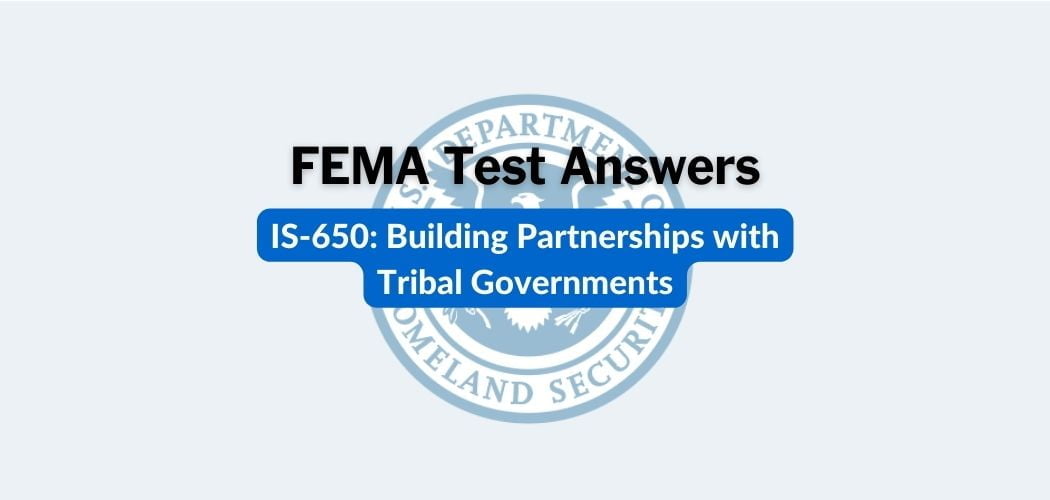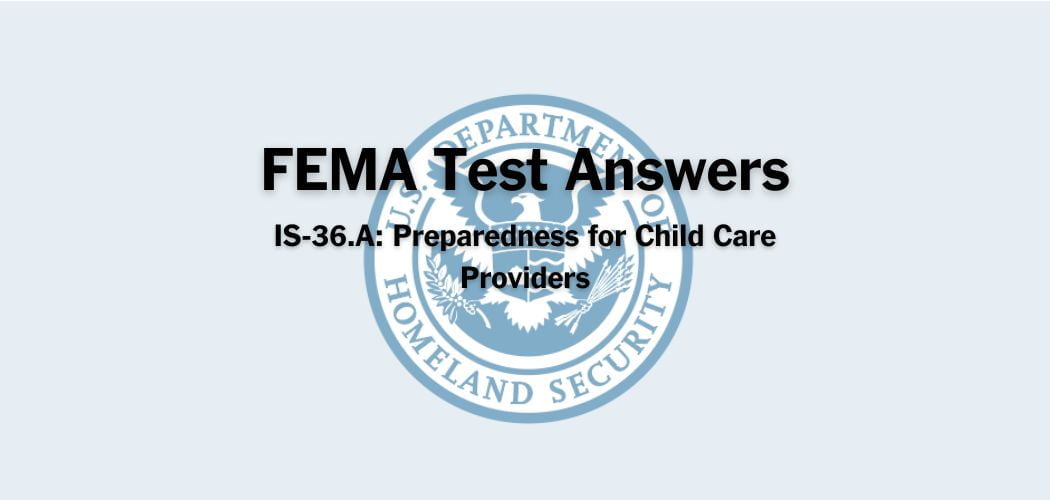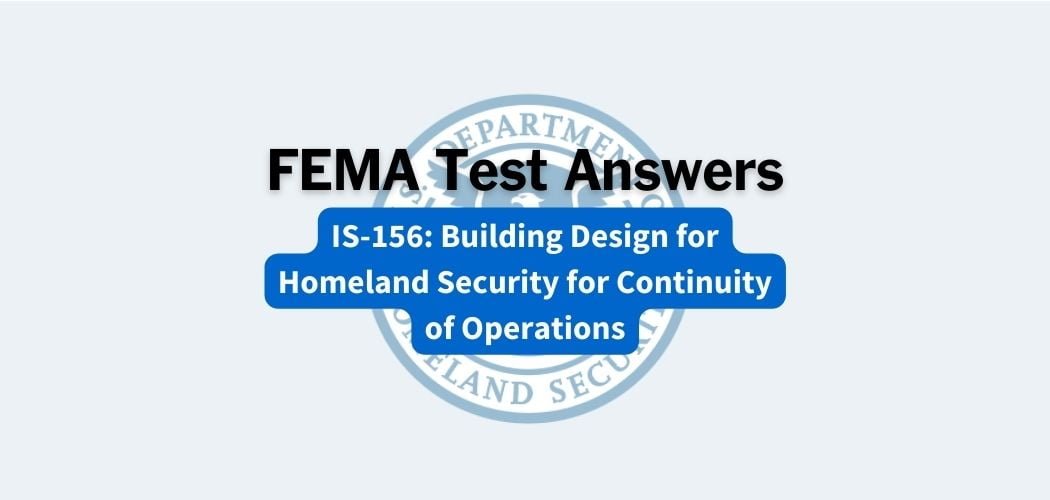Overview: FEMA IS-870A course was published on 7/2/2014 as the first course in the Dams Sector web-based training series. The second course is the IS-871 and the third one is the IS-872. The purpose of this series of courses is to provide owners and operators with information pertaining to security awareness, protective measures, and crisis management.
FEMA IS-870A addresses crisis management activities as an important component of an overall Risk Management Program and provides dam and levee stakeholders with recommendations to assist in the development of various plans focused on enhancing Preparedness, protection, recovery, and resilience capabilities.
FEMA IS-870A test answers
Each time this test is loaded, you will receive a unique set of questions and answers. The test questions are scrambled to protect the integrity of the exam.
Question 1. TRUE or FALSE: A hot wash is a facilitated discussion held immediately following an exercise among exercise players from each functional area
A. TRUE✅
B. FALSE
Question 2. TRUE or FALSE: Guidance on protecting Dams Sector facilities is provided in the National Infrastructure Protection Plan, the Dams Sector-Specific Plan, and the Dams Sector handbook series.
A. TRUE✅
B. FALSE
Question 3. Which type of exercise involves a simulation of operations using two or more teams and rules, data, and procedures to depict an actual or assumed real-life situation?
A. Full-scale exercises
B. Functional exercises
C. Games✅
D. Drills
Question 4. One of the purposes of a _____ is to minimize economic losses through quick restoration of function.
A. Emergency Action Plan
B. Recovery Plan✅
C. Security Plan
D. Continuity Plan
Question 5. Which of the following includes the notification flowchart to be used in an incident?
A. Emergency Action Plan✅
B. Recovery Plan
C. Security Plan
D. Continuity Plan
Question 6. TRUE or FALSE: Crisis management plans require frequent review and revision to reflect changes in personnel of various organizations and changes in communications systems.
A. TRUE✅
B. FALSE
Question 7. Which type of plan would be activated in response to employee absence during an influenza pandemic?
A. Emergency Action Plan
B. Recovery Plan
C. Security Plan
D. Continuity Plan✅
Question 8. Which type of discussion-based exercise would be most useful for developing a draft plan?
A. Game
B. Tabletop
C. Seminar
D. Workshop✅
Question 9. Pandemic preparedness guidelines recommend that owners and operators of critical infrastructure be prepared to sustain essential assets for up to 12 weeks
A. TRUE✅
B. FALSE
Question 10. Which type of exercises are low-level exercises used for testing, developing, or maintaining skills in a single emergency response procedure?
A. Full-scale exercises
B. Functional exercises
C. Games
D. Drills✅
Question 11. TRUE or FALSE: Crisis management plans often receive wide distribution, and it might be necessary to exclude sensitive information from some copies
A. TRUE✅
B. FALSE
Question 12. Which is an optimal way to familiarize participants with current plans, policies, agreements, and procedures, or may be used to develop new plans, policies, agreements, and procedures?
A. Discussion-based exercises✅
B. Reading assignments and quizzes
C. On-the-job training
D. Operations-based exercises
Question 13. _____ estimates should not only include what an aggressor/adversary might be expected to do, but also likely tactics, tools, weapons, or explosives.
A. Risk
B. Threat✅
C. Consequence
D. Vulnerability
Question 14. During which type of exercise would downstream residents practice evacuation?
A. Full-scale exercise
B. Functional exercise
C. Game
D. Drill✅
Question 15. TRUE or FALSE: State safety officials are responsible for the development of each Dam Sector facility’s emergency action plan.
A. TRUE✅
B. FALSE
Question 16. A facility’s use by the public for recreation presents the potential for which type of site-related vulnerability?
A. Emergency planning and preparedness
B. Industrial systems control
C. Access and access control✅
D. Operational security
Question 17. TRUE or FALSE: It is advisable to begin recovery actions only AFTER the response phase of an incident is fully completed.
A. TRUE✅
B. FALSE
Question 18. Which of the following is assessed as a function of consequences, vulnerabilities, and threats?
A. Hazard
B. Preparedness
C. Risk✅
D. Security
Question 19. Casualties resulting from a facility failure is considered to be what type of consequence?
A. Impact on government capability
B. Impact on public confidence
C. Human impact✅
D. Economic impact
Question 20. Which type of activity is done with planners, facilitators, controllers, and evaluators following an exercise?
A. Seminar to address procedures needing revision
B. Independent evaluation of each person’s performance
C. Workshop to identify problems
D. Facilitated debrief to elicit feedback✅
Critical Infrastructure Security and Resilience Curriculum
Sector-specific courses
- IS-870: Dam Sector: Crisis Management
- IS-871: Dam Sector: Security Awareness
- IS-872: Dam Sector: Protective Measures
- IS-1170: Introduction to the Interagency Security Committee (ISC)
- IS-1171: Overview of Interagency Security Committee (ISC) Publications
- IS-1172: The Risk Management Process for Federal Facilities: Facility Security Level (FSL) Determination
- IS-1173: Levels of Protection (LOP) and Application of the Design-Basis Threat (DBT) Report
- IS-1174: Facility Security Committees
Foundational courses
- IS-860: The National Infrastructure Protection Plan
- IS-913: Critical Infrastructure Security and Resilience: Achieving Results through Partnership and Collaboration
Security awareness courses
- IS-906: Workplace Security Awareness
- IS-907: Active Shooter: What You Can Do
- IS-912: Retail Security Awareness: Understanding the Hidden Hazards
- IS-914: Surveillance Awareness: What You Can Do
- IS-915: Protecting Critical Infrastructure Against Insider Threats
- IS-916: Critical Infrastructure Security: Theft and Diversion – What You Can do



